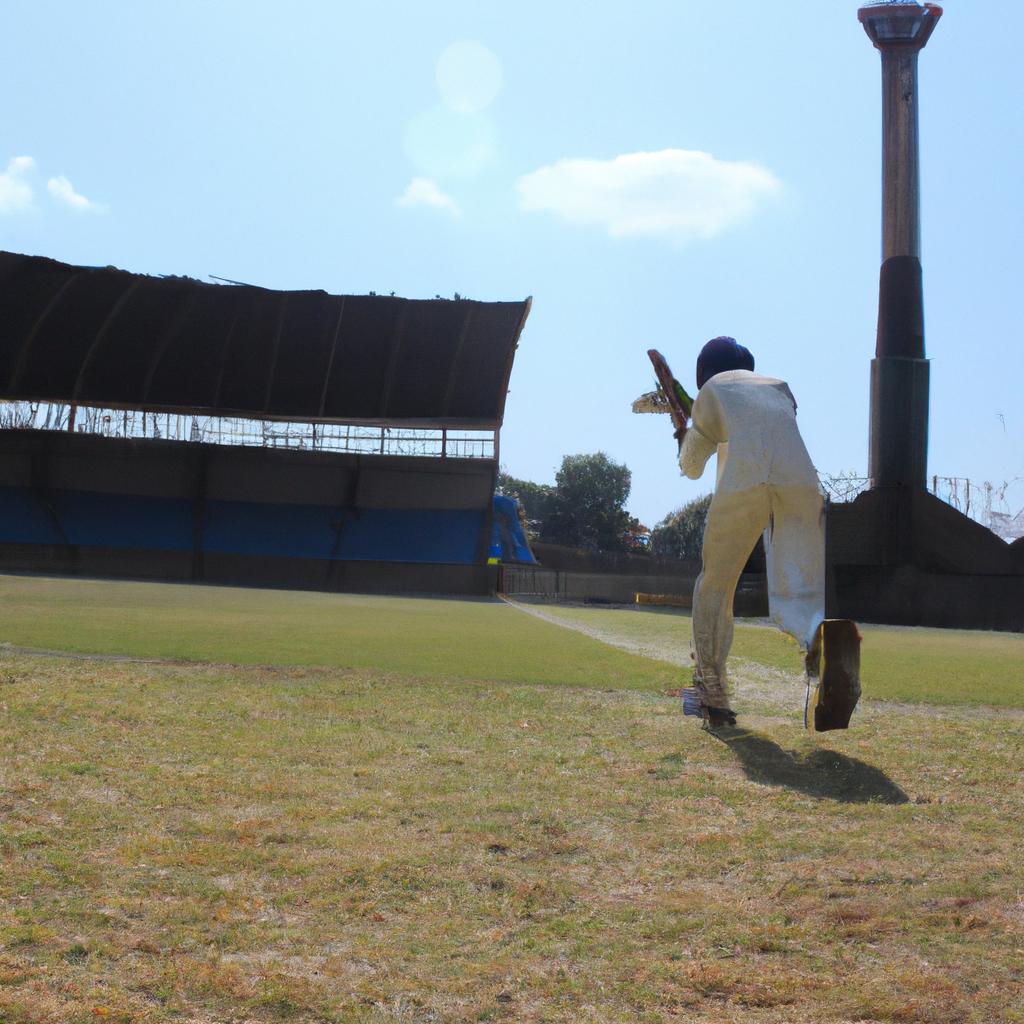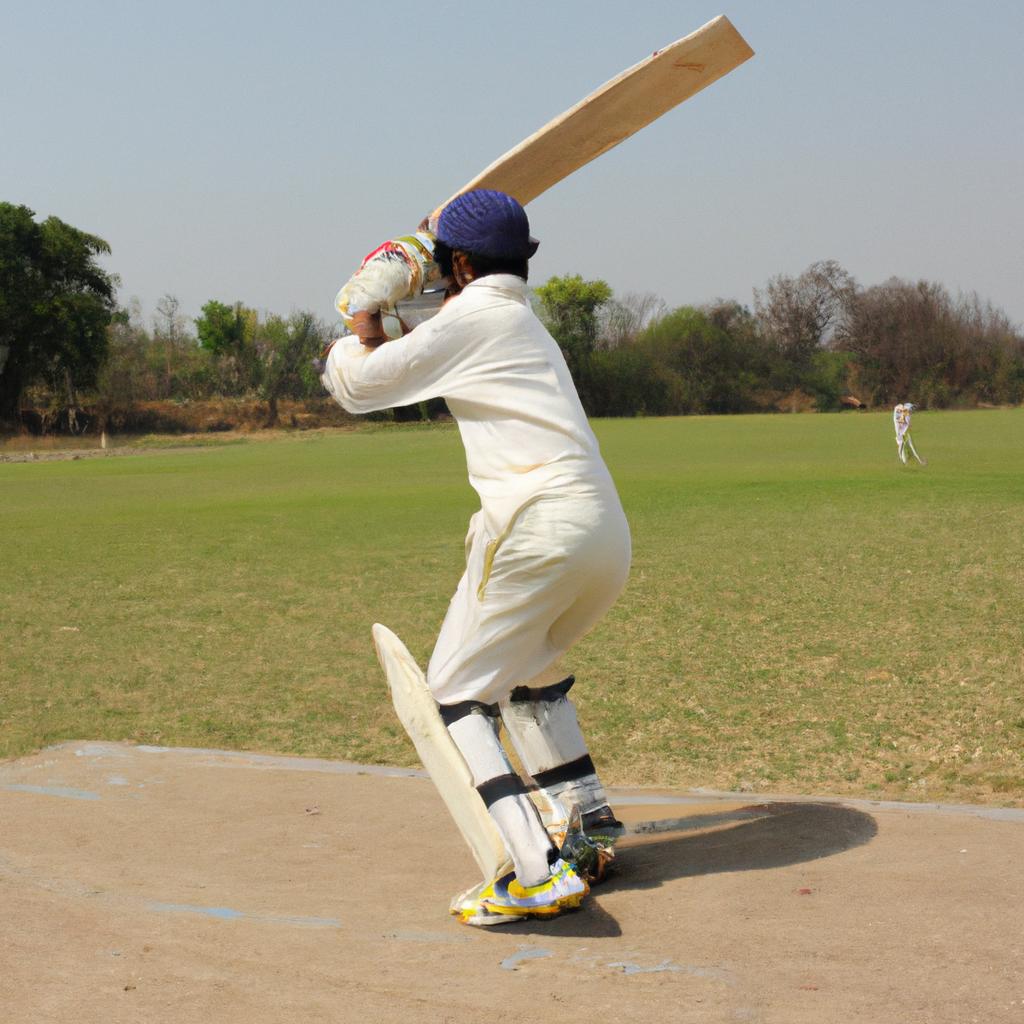In the world of sports, cricket stands out as one of the most popular and globally recognized games. Originating in England during the 16th century, this bat-and-ball sport has evolved over time to include various formats and variations. These different types of cricket formats have revolutionized the game, catering to diverse audiences and emphasizing distinct aspects of skill and strategy.
One example that highlights the impact of different cricket formats is the emergence of Twenty20 (T20) cricket. Introduced in 2003 by the England and Wales Cricket Board (ECB), T20 quickly gained popularity due to its fast-paced nature and spectator-friendly format. This shorter version of the game consists of each team batting for a maximum of 20 overs, resulting in intense matches with higher scores and increased excitement levels. The success of T20 led to other nations adopting this format, sparking a global phenomenon that changed how cricket was played and perceived.
These varying cricket formats cater to different preferences within both players and spectators alike. Test cricket, for instance, emphasizes endurance, technique, and patience while spanning five days across four innings. In contrast, One Day Internationals (ODIs) provide a balance between traditional elements and limited-overs gameplay by allowing each team 50 overs per match. ODIs are known for their strategic approach, where teams aim to strike a balance between scoring runs and preserving wickets throughout the innings.
Another format that has gained prominence in recent years is the T10 cricket. As the name suggests, T10 matches consist of each team batting for only 10 overs, resulting in even more fast-paced and high-scoring encounters. This format appeals to those seeking instant gratification and action-packed entertainment within a shorter timeframe.
The rise of these different cricket formats has also had a significant impact on player skills and strategies. For instance, T20 cricket demands aggressive batting, innovative shot-making, and quick decision-making under pressure. Bowlers need to adapt by developing variations and mastering precise execution to contain batsmen in this format’s power-hitting frenzy.
Overall, the introduction of various cricket formats has brought diversity to the game, appealing to different audiences and showcasing distinct aspects of skill and strategy. From traditional Test matches to the electrifying T20 contests, cricket enthusiasts can now enjoy a wide range of options that cater to their preferences while keeping the spirit of the game alive.
Test cricket
Test cricket is the longest and oldest format of the game, characterized by matches that can last up to five days. This format allows for a comprehensive examination of players’ skills, endurance, and mental strength. For instance, in a hypothetical scenario, let us consider a test match between Australia and England where both teams battle it out over five grueling days at Lord’s Cricket Ground.
Firstly, Test cricket offers an extensive range of challenges due to its longer duration. Players need to display not only their technical proficiency but also tactical acumen throughout the course of the match. The slow-paced nature of this format demands patience from both batsmen and bowlers as they carefully assess playing conditions and strategize accordingly. Moreover, since there are no restrictions on the number of overs per day or innings, Test cricket tests players’ physical fitness and resilience.
Secondly, Test cricket provides ample time for individual performances to shine and contribute towards team success. This format allows players to showcase their abilities across multiple days and various situations within a single match. Batsmen have the opportunity to exhibit concentration, shot selection, and adaptability against different types of bowling attacks. Similarly, bowlers can exploit subtle changes in pitch conditions over time to deceive batsmen with variation in line, length, pace, or spin.
To illustrate further emotional aspects associated with Test cricket:
- Nail-biting finishes: Matches often go down to the wire with thrilling conclusions that keep spectators on edge.
- Epic rivalries: Iconic contests like Ashes series between England and Australia capture public imagination due to historical significance.
- Unforgettable records: Achievements such as Brian Lara’s 400 runs in an inning or Muttiah Muralitharan’s 800 wickets stand testament to outstanding individual feats.
- Timeless memories: Spectators cherish witnessing extraordinary performances unfold gradually over several days.
Additionally, here is a table showcasing some key features of Test cricket:
| Features | Description |
|---|---|
| Duration | Matches can last up to five days |
| Innings | Both teams bat and bowl twice in a match |
| Playing conditions | Pitch characteristics evolve over time due to wear and tear |
| Captains’ strategies | Tactical decisions impact the outcome of the match |
Moving forward, we will explore another popular format known as One Day International (ODI) cricket. This limited-overs version presents a stark contrast to the extended battles seen in Test cricket while offering its own unique set of challenges and thrills.
One Day International (ODI) cricket
Test cricket, the oldest and longest format of the game, is known for its traditional and strategic approach. However, as time progressed, a need arose for shorter formats that could attract larger audiences and generate more excitement. This led to the introduction of One Day International (ODI) cricket, which revolutionized the sport.
Imagine a thrilling ODI match between two rival teams where emotions run high among players and spectators alike. The tension builds up as the batting team tries to chase down a formidable target set by their opponents in limited overs. The pressure mounts, but it also creates an electrifying atmosphere that keeps everyone on the edge of their seats.
In comparison to Test cricket’s five-day duration, ODIs are played over 50 overs per side. Here are some key characteristics of this format:
- Limited Overs: Each team gets only a specified number of overs to bat and bowl.
- Time Constraint: Matches have a fixed duration, usually lasting around eight hours.
- Aggressive Approach: Due to limited overs, batsmen tend to adopt an aggressive style of play right from the beginning.
- Result-Oriented: Unlike Test matches that can end in draws, ODIs always produce a result.
| Key Differences Between Test Cricket & ODI Cricket |
|---|
| Aspect |
| Duration |
| Number of Innings Per Team |
| Over Limit Per Innings |
One Day Internationals brought about several changes in cricket – faster scoring rates, innovative shot-making techniques, and strategic bowling variations aimed at restricting runs while taking wickets. These developments made ODIs immensely popular worldwide and paved the way for the next evolution in cricket: Twenty20 (T20) cricket.
Transitioning from ODIs to T20 cricket, this format takes the excitement and intensity of limited-overs matches to a whole new level.
Twenty20 (T20) cricket
Moving on from One Day International (ODI) cricket, another popular format is Twenty20 (T20) cricket. This fast-paced and thrilling variant of the game has gained immense popularity worldwide since its introduction in 2003.
T20 cricket is characterized by its shortened duration, with matches typically lasting around three hours. Unlike ODI cricket, where each team gets 50 overs to bat and bowl, T20 matches consist of just 20 overs per side. This condensed format adds an element of urgency and excitement to the game as players are required to adopt a more aggressive approach.
To illustrate the impact of T20 cricket, let’s consider a hypothetical scenario involving two teams competing in this format. Team A boasts power hitters capable of launching big sixes, while Team B relies on their spinners who excel at taking wickets. The match unfolds in a nail-biting manner as Team A relentlessly goes for boundaries, but Team B’s spinners use their skills to restrict the scoring rate. Ultimately, it comes down to the final over where Team A requires eight runs off six balls with one wicket remaining. The tension builds up as spectators hold their breaths in anticipation of an exhilarating finish.
The popularity of T20 cricket can be attributed to several factors:
- High-intensity gameplay that keeps audiences engaged throughout.
- Greater opportunities for batsmen to showcase their skills through explosive hitting.
- Increased competitiveness among teams due to shorter playing time.
- Enhanced spectator experience with live music, cheerleaders, and colorful uniforms adding entertainment value.
| Factors contributing | Emotional Response |
|---|---|
| High-intensity gameplay | Excitement |
| Explosive hitting | Adrenaline rush |
| Shorter playing time | Anticipation |
| Enhanced spectator experience | Entertainment |
As we delve deeper into the world of cricket formats, our next section will explore the unique characteristics of County cricket, a traditional and highly regarded form of the game in England. This format provides a platform for players to showcase their skills in extended matches spanning multiple days.
Moving on from T20 cricket, we now turn our attention to County cricket.
County cricket
Twenty20 (T20) cricket is a fast-paced and exciting format that has gained immense popularity in recent years. With its shorter duration and high-intensity gameplay, T20 matches have captivated audiences around the world. To further explore the variations within cricket formats, we now turn our attention to County cricket.
County cricket, played primarily in England and Wales, is another significant form of the game. It involves teams representing different counties competing against each other over multiple days. One example of this format is the famous Ashes series between Australia and England, where both sides compete for one of the most prestigious trophies in cricket. County cricket offers a unique blend of traditional techniques and strategic gameplay that sets it apart from other formats.
To understand the key aspects of County cricket, let’s delve into some notable characteristics:
- Duration: Unlike Twenty20 matches that last only a few hours, County cricket games can stretch over several days. This extended timeframe allows players to showcase their skills across varied conditions and test their endurance as they strive for victory.
- Strategic Approach: In contrast to the explosive nature of T20 cricket, County matches require a more patient approach from both batsmen and bowlers. The game revolves around building partnerships, accumulating runs steadily, and applying consistent pressure on the opposition.
- Wicket Conditions: As the match progresses over multiple days, wickets tend to deteriorate due to wear and tear. This factor plays a crucial role in determining team strategies since batting becomes more challenging on worn-out pitches.
- Player Development: County cricket acts as a breeding ground for talent development at grassroots levels. Many young cricketers find opportunities to hone their skills while playing alongside experienced professionals.
The following table highlights some distinguishing features of Twenty20 (T20) and County cricket:
| Twenty20 (T20) Cricket | County Cricket | |
|---|---|---|
| Duration | Short matches, usually completed in a few hours | Matches can span multiple days |
| Style of Play | Aggressive and fast-paced | Methodical and patient |
| Wicket Conditions | Generally favors batsmen | Can deteriorate over time |
| Talent Development | Provides exposure to young players | Offers opportunities for talent nurturing |
County cricket encompasses the essence of traditional cricket while allowing players to exhibit their skills across longer durations. This format is deeply rooted in history and has contributed significantly to the development of the sport. Moving forward, we will explore another intriguing variation known as List A cricket.
Transitioning into the subsequent section about “List A cricket,” we now turn our attention to yet another fascinating variant within the world of cricket.
List A cricket
Moving on from the county cricket, let us now explore another format of cricket known as List A cricket.
List A Cricket:
To understand List A cricket, imagine a scenario where two teams are competing against each other in a limited-overs match. The players wear colored jerseys instead of traditional whites. This format provides an exciting platform for cricketers to showcase their skills and entertain fans worldwide.
Here are some reasons why List A cricket captures the hearts of both players and spectators:
- Thrilling encounters between highly skilled professionals
- Dynamic gameplay with aggressive batting and strategic bowling
- Nail-biting finishes that keep fans at the edge of their seats
- Opportunities for young talents to prove themselves on a grand stage
Table:
Let’s take a closer look at how various aspects differ in List A cricket compared to its counterparts:
| Aspect | First-class Cricket | One Day Internationals (ODIs) | List A Cricket |
|---|---|---|---|
| Duration | Multiple days | Limited overs | Limited overs |
| Number of Teams | Two | International | Domestic |
| Overs per side | Unlimited | Fixed | Fixed |
| Fielding rules | No field restrictions | Powerplays and fielding restrictions | Powerplays and fielding restrictions |
In this table, we can observe the contrasting characteristics among different formats of cricket, highlighting how List A cricket stands out as an exhilarating limited-over game played domestically.
Moving forward into our discussion, we’ll delve deeper into first-class cricket which holds immense historical significance in the world of this sport.
First-class cricket
List A cricket is another format of the game that falls between First-class cricket and Twenty20 matches in terms of duration and intensity. It is a limited-overs format, typically played over 50 overs per side, making it longer than Twenty20 but shorter than traditional Test matches. One example of List A cricket is the popular ICC Cricket World Cup, where teams from different countries compete against each other to win the prestigious trophy.
This format brings its own set of variations and strategies compared to other forms of cricket. Here are some key aspects that distinguish List A cricket:
- Limited Overs: Unlike first-class matches, List A games have a predetermined number of overs for each team. This time limit adds urgency to the game and often leads to more aggressive batting approaches as teams aim to score quickly within the given overs.
- Powerplays: List A matches incorporate powerplay periods where fielding restrictions are enforced, allowing batsmen an opportunity to capitalize on scoring opportunities during these phases.
- Duckworth-Lewis Method: In case weather interruptions affect the match duration, List A games use the Duckworth-Lewis method to calculate revised targets for both teams, ensuring fairness despite any disruptions.
- Player Restrictions: Some tournaments may impose specific player eligibility criteria or squad composition rules unique to List A cricket, adding further complexity and strategic decisions for team management.
To better understand these differences, let’s take a look at how they compare across various formats of cricket:
| Format | Duration | Number of Overs | Fielding Restrictions |
|---|---|---|---|
| Test Matches | Multiple days | Unlimited | No |
| First-class | Several days | Unlimited | No |
| List A | Single day | 50 | Yes |
| T20 | Few hours | 20 | Yes |
As can be seen, List A cricket provides a balanced gameplay experience with limited overs and fielding restrictions, making it an exciting format for both players and spectators. Participating teams strategize their approach based on the number of overs available and adapt to changing circumstances during the match.
In summary, List A cricket serves as a bridge between traditional first-class matches and fast-paced Twenty20 games. It offers limited-overs excitement while maintaining certain strategic elements from longer formats. With its unique features such as powerplays and Duckworth-Lewis method, List A cricket showcases the dynamic nature of the sport, providing thrilling encounters for fans worldwide.










